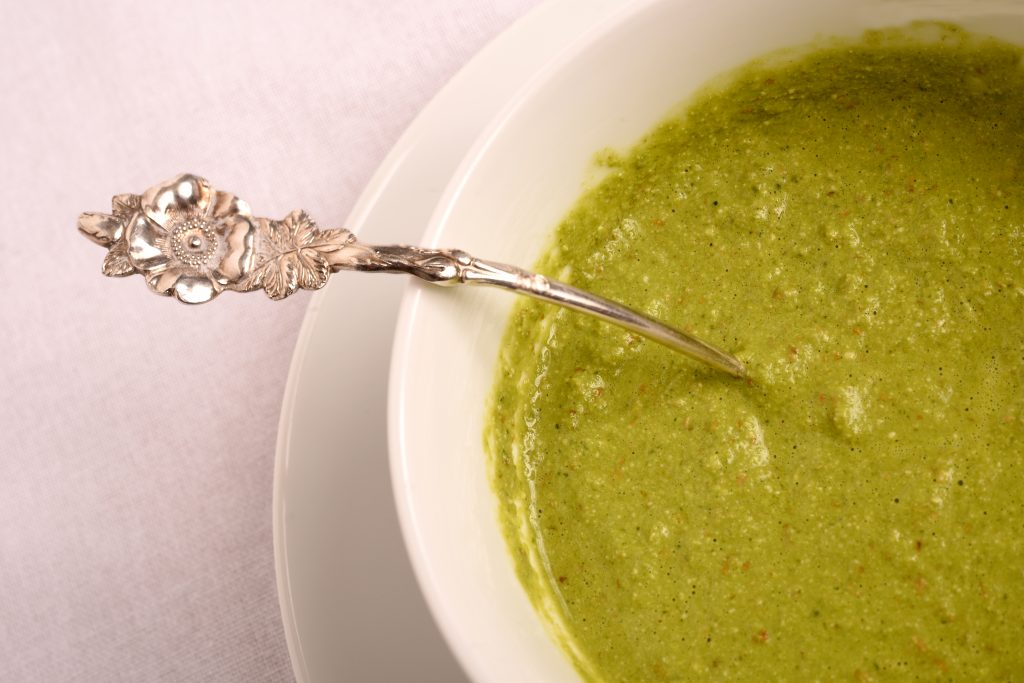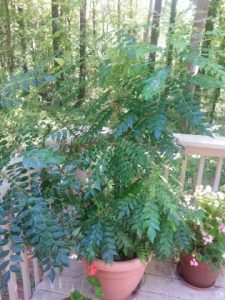Seven-Minute Sides: Mild Curry Leaf Chutney

Photo by Roger Winstead
This curry leaf and cilantro chutney recipe comes from Vaidya Smita Naram. She whipped up this lovely sauce in our Vitamix in about 5 minutes while recently staying in our home. My husband, Tom, and I happily poured it over mung bean “burgers” I had made for dinner. A few days later I prepared another cup of the chutney, which we used to top off savory chickpea pancakes that Dr. Smita showed me how to make a half-hour before we drove her to the airport for her flight home to Mumbai, India.
Chutneys are relishes or sauces that are staples in Indian cuisine. They are also used in Ayurvedic cooking when freshly made. There are innumerable kinds of chutneys — some chunky, others that are more like a paste, and liquid sauces. Chutneys have a reputation for being amazingly hot to the tongue because most Indian cooks spike their chutneys with chilies. Not so with this recipe! Authentic Ayurvedic cuisine avoids the use of chilies except for people who are predominantly kapha types. Nonetheless, this chutney is guaranteed to add a bolt of flavor to any dish along with potent healing power.
QUICK PRIMER ON CURRY LEAVES: If you’re not familiar with curry leaves, it’s important not to confuse them with the term curry. A curry is a dish smothered in a delicious gravy, which is made with curry leaves and a collection of ground spices — usually infused with cayenne or other dried chili peppers. You can also find prepared spice collections that are labeled “curry.” Curry leaves, by themselves, have no heat but they do have a distinctive flavor, which is why they are typically added to curried dishes and are often added to chutneys. Curry leaves are considered tridoshic, which means they are balancing for every constitution. Curry leaves have numerous medicinal benefits, and they are often recommended by Ayurvedic practitioners to support digestion and lower blood sugar. Dr. Naram says that this particular recipe is an ideal remedy for arthritis because of the anti-inflammatory nature of both the curry leaves and cilantro. Curry leaves are also high in calcium, which nourishes the bones.
You can find organic curry leaves online. If you need them today, you can usually find them in Indian groceries and sometimes at Whole Foods. Fortunately, we have our own curry tree at home, which was given to us as a gift from Praveena and Baldev Thakur of Charlotte about a decade ago when the plant was perhaps six inches high. Our tree, which I named Annapurna (after the goddess of food), thrives in the summer on our deck in bright sunlight and lots of water. Somehow she manages to stay alive when we bring her inside for the winter, sitting by a glass door with morning sun pouring in. By last summer she was close to five feet tall after having been repotted several times.
This one simple chutney will enliven your most tired old recipes, so you may want to try it on everything from steamed vegetables to beans-and-rice to veggie burgers.





